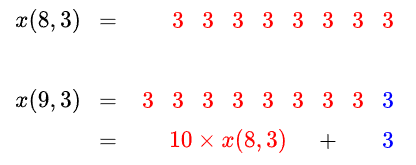A - Repdigit Number Editorial by evima
Hints → https://atcoder.jp/contests/arc149/editorial/4961
[1] Basic policy
For positive integers \(1\leq d\leq 9\) and \(n\), let \(x(n, d)\) denote the integer made by concatenating \(n\) copies of \(d\):
\[x(n, d) = \underbrace{dd\cdots dd}_{n}\]
.
The problem asks us to find the maximum integer that can be written as \(x(n, d)\) (\(1\leq n\leq N\), \(1\leq d\leq 9\)) and is a multiple of \(M\). Since there are \(9N\) numbers \(x(n, d)\) in total, even if we do a computation taking \(O(1)\) time for every \(x(n,d)\), it takes \(O(N)\) time in total. It leads us to think of the following solution.
- Compute \(x(n, d) \bmod M\) for every \((n, d)\).
- Find the maximum \(x(n,d)\) such that \(x(n, d) \bmod M = 0\).
The second part, finding the maximum, is simple: we just choose the one with the maximum \(d\) among the ones with the maximum \(n\). Below, let us explain how to compute \(x(n, d) \bmod M\) for every \((n, d)\).
[2] Computing \(x(n,d) \bmod M\)
Here are two ways to compute \(x(n,d)\bmod M\) assuming that \(x(n-1,d) \bmod M\), etc. are already known, allowing us to find all the desired \(x(n,d)\bmod M\) in \(O(N)\) time.
[2 - 1] Computing \(x(n,d)\) (1)
By noting that \(x(n-1, d)\) is a prefix of \(x(n,d)\), we see that:
\[x(n,d) = 10x(n-1,d) + d\]
.
One can compute each \(x(n,d)\bmod M\) in \(O(1)\) time by using this formula to do the computation in ascending order of \(n\).

[2 - 2] Computing \(x(n,d)\) (2)
By noting that \(x(n-1, d)\) is a suffix of \(x(n,d)\), we see that:
\[x(n,d) = d\times 10^{n-1} + x(n-1,d).\]
If one uses this formula, one also needs the values \(10^{n-1}\bmod M\), which can also be computed in ascending order of \(n\) using \(10^n = 10\times 10^{n-1}\), allowing one to compute each \(x(n,d)\bmod M\) in \(O(1)\) time again.

[3] Advanced topics
One can also find the \((n,d)\) giving the maximum faster, as follows.
- Fix \(d\).
- Find the smallest positive integer \(n\) such that \(x(n,d)\) is a multiple of \(M\), which can be done similarly to Problem G in ABC 270 by noting \(x(n,d) = 10x(n-1,d) + d\).
- Let \(n_0\) be the smallest positive integer \(n\) such that \(x(n,d)\) is a multiple of \(M\). Then, one can prove that \(x(n,d)\) is a multiple of \(M\) if and only if \(n\) is a multiple of \(n_0\). Thus, one can find the largest \(n\) by finding the largest multiple of \(n_0\) at most \(N\), which can be done in \(O(1)\) time.
This method allows one to find the optimal \((n,d)\) in an expected time complexity of \(O(\sqrt{N})\) etc. One can find it even faster by using fast prime factorization, \(x(n,d) = d\cdot \frac{10^n-1}{9}\), and Euler’s theorem, etc.
In this problem, however, it takes \(\Omega(N)\) time to print the answer, so these methods do not allow one to solve it in \(o(N)\) time.
Sample submission
posted:
last update: